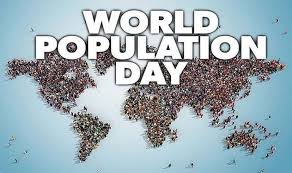World Population Day

11 July – World Population Day
History of World Population Day:
It was inspired by the public interest in Five Billion Day on July 11, 1987, the approximate date on which the world’s population reached five billion people. The day came about in 1989 when it was established by the Governing Council of the United Nations Development Programme. The United Nations General Assembly decided to continue observing this day.
Significance of World Population Day:
This day is significant as it highlights the problems of overpopulation, raises awareness about the effects of overpopulation on the environment and development. It also talks about the health problems faced by child bearing women and the importance of family planning, gender equality, poverty, maternal health and human rights.
Theme of World Population Day 2020:
The theme for 2020 is based on safeguarding the health and rights of women and girls around the world especially during the time of COVID-19 pandemic. A recent UNFPA research highlighted that due to lockdown in various parts of world resulting in major disruption to health services, will impact to 45 to 50 million women in low and middle-income countries. They might not have access to modern contraceptives and leading to 7 million unintended pregnancies. Apart from that, it could see a rise in gender-based violence, female genital mutilation and child marriages.
World Population Trends
It took hundreds of thousands of years for the world population to grow to 1 billion – then in just another 200 years or so, it grew sevenfold. In 2011, the global population reached the 7 billion mark, and today, it stands at about 7.7 billion, and it's expected to grow to around 8.5 billion in 2030, 9.7 billion in 2050, and 10.9 billion in 2100.
This dramatic growth has been driven largely by increasing numbers of people surviving to reproductive age, and has been accompanied by major changes in fertility rates, increasing urbanization and accelerating migration. These trends will have far-reaching implications for generations to come.
The recent past has seen enormous changes in fertility rates and life expectancy. In the early 1970s, women had on average 4.5 children each; by 2015, total fertility for the world had fallen to below 2.5 children per woman. Meanwhile, average global lifespans have risen, from 64.6 years in the early 1990s to 72.6 years in 2019.
In addition, the world is seeing high levels of urbanization and accelerating migration. 2007 was the first year in which more people lived in urban areas than in rural areas, and by 2050 about 66 per cent of the world population will be living in cities.
These megatrends have far-reaching implications. They affect economic development, employment, income distribution, poverty and social protections. They also affect efforts to ensure universal access to health care, education, housing, sanitation, water, food and energy. To more sustainably address the needs of individuals, policymakers must understand how many people are living on the planet, where they are, how old they are, and how many people will come after them.

Premier Records Processing Authority !!
Global Records & Research Foundation
Head Office : A 19, Savitri Green 2, Gazipur Road, Zirakpur, Dist. SAS Nagar, Punjab (India) Pin 140603
# +91 9915049550 , +91 9317949550
info@grrfrecords.com , grrfrecords@gmail.com



